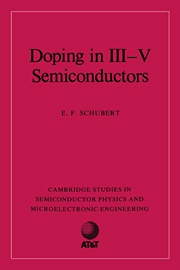Book contents
- Frontmatter
- Contents
- Foreword
- Preface
- List of symbols
- Introduction
- 1 Shallow impurities
- 2 Phenomenology of deep levels
- 3 Semiconductor statistics
- 4 Growth technologies
- 5 Doping with elemental sources
- 6 Gaseous doping sources
- 7 Impurity characteristics
- 8 Redistribution of impurities
- 9 Deep centers
- 10 Doping in heterostructures, quantum wells, and superlattices
- 11 Delta doping
- 12 Characterization techniques
- Appendix A Properties of III–V semiconductors
- Appendix B Constants and conversions
- References
- Index
9 - Deep centers
Published online by Cambridge University Press: 05 October 2010
- Frontmatter
- Contents
- Foreword
- Preface
- List of symbols
- Introduction
- 1 Shallow impurities
- 2 Phenomenology of deep levels
- 3 Semiconductor statistics
- 4 Growth technologies
- 5 Doping with elemental sources
- 6 Gaseous doping sources
- 7 Impurity characteristics
- 8 Redistribution of impurities
- 9 Deep centers
- 10 Doping in heterostructures, quantum wells, and superlattices
- 11 Delta doping
- 12 Characterization techniques
- Appendix A Properties of III–V semiconductors
- Appendix B Constants and conversions
- References
- Index
Summary
Deep centers are chemical impurities, native defects, or a combination of both, which have at least one energy level in the forbidden gap. The energy level or levels of deep centers are far removed from the conduction and valence band edges, which is in contrast to shallow impurities. The phenomenology of deep centers was discussed and analyzed in Chap. 2. In the present chapter, the characteristics of some specific deep centers will be summarized.
The DX-center is of primary technological importance in n-type AlxGa1−x As devices such as transistors and lasers. The properties of this center have puzzled researchers for more than a decade. The EL2 center can cause undoped bulkgrown GaAs to be semi-insulating. The EL2 center is of importance for the growth of GaAs bulk crystals and for the production of substrates. Hydrogen can be used in two different ways to influence the electronic properties of III–V semiconductors. First, protons implanted into III–V semiconductors cause damage to the crystal; the damaged regions can trap carriers. Second, hydrogen can passivate acceptor as well as donor impurities. Oxygen is also used to render III–V semiconductors semi-insulating. Chromium and iron are deep impurities which are used to make GaAs and InP highly resistive. Both Cr and Fe are deep acceptors and compensate for residual shallow donors in the two semiconductors.
Information
- Type
- Chapter
- Information
- Doping in III-V Semiconductors , pp. 354 - 391Publisher: Cambridge University PressPrint publication year: 1993
Accessibility standard: Unknown
Why this information is here
This section outlines the accessibility features of this content - including support for screen readers, full keyboard navigation and high-contrast display options. This may not be relevant for you.Accessibility Information
- 1
- Cited by
